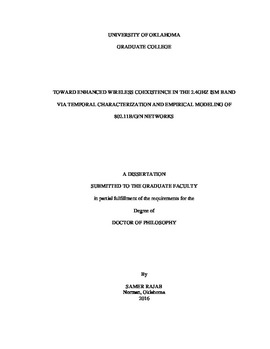| dc.contributor.advisor | Refai, Hazem H. | |
| dc.contributor.author | Rajab, Samer | |
| dc.date.accessioned | 2016-03-28T16:02:33Z | |
| dc.date.available | 2016-03-28T16:02:33Z | |
| dc.date.issued | 2016 | |
| dc.identifier.uri | https://hdl.handle.net/11244/33191 | |
| dc.description.abstract | This dissertation presents an extensive experimental characterization and empirical modelling of 802.11 temporal behavior. A detailed characterization of 802.11b/g/n homogeneous and heterogeneous network traffic patterns is featured, including idle time distribution and channel utilization.
Duty cycle serves as a measure for spectrum busyness. Higher duty cycle levels directly impact transceivers using the spectrum, which either refrain from transmission or suffer from increased errors. Duty cycle results are provided for 802.11b, g and n Wi-Fi technologies at various throughput levels. Lower values are observed for 802.11b and g networks. Spectrum occupancy measurements are essential for wireless networks planning and deployment.
Detailed characterization of 802.11g/n homogeneous and heterogeneous network traffic patterns, including activity and idle time distribution are presented. Distributions were obtained from time domain measurements and represent time fragment distributions for active and inactive periods during a specific test. This information can assist other wireless technologies in using the crowded ISM band more efficiently and achieve enhanced wireless coexistence.
Empirical models of 802.11 networks in the 2.4 GHz Industrial, Scientific, and Medical (ISM) band are also presented. This information can assist other wireless technologies aiming to utilize the crowded ISM band more efficiently and achieve enhanced wireless coexistence. In this work models are derived for both homogeneous and heterogeneous 802.11 network idle time distribution.
Additionally, two applications of 802.11 networks temporal characterization are presented. The first application investigates a novel method for identifying wireless technologies through the use of simple energy detection techniques to measure the channel temporal characteristics including activity and idle time probability distributions. In this work, a wireless technology identification algorithm was assessed experimentally. Temporal traffic pattern for 802.11b/g/n homogeneous and heterogeneous networks were measured and used as algorithm input. Identification accuracies of up to 96.83% and 85.9% are achieved for homogeneous and heterogeneous networks, respectively. The second application provides a case study using 802.15.4 ZigBee transmitter packet size on-line adjustments is also presented. Packet size is adaptively modified based on channel idle time distribution obtained using simple channel power measurements. Results demonstrate improved ZigBee performance and significant enhancement in throughput as a result of using adaptive packet size transmissions. | en_US |
| dc.language | en | en_US |
| dc.subject | Wireless communication | en_US |
| dc.subject | Spectrum Utilization Analysis | en_US |
| dc.subject | Time domain Spectrum modeling | en_US |
| dc.subject | ISM Band | en_US |
| dc.subject | Machine learning | en_US |
| dc.title | TOWARD ENHANCED WIRELESS COEXISTENCE IN THE 2.4GHZ ISM BAND VIA TEMPORAL CHARACTERIZATION AND EMPIRICAL MODELING OF 802.11B/G/N NETWORKS A DISSERTATION | en_US |
| dc.contributor.committeeMember | Adams, Curts | |
| dc.contributor.committeeMember | Dyer, John | |
| dc.contributor.committeeMember | Imran, Ali | |
| dc.contributor.committeeMember | Runolfsson, Thordur | |
| dc.date.manuscript | 2016 | |
| dc.thesis.degree | Ph.D. | en_US |
| ou.group | College of Engineering::School of Electrical and Computer Engineering | en_US |
